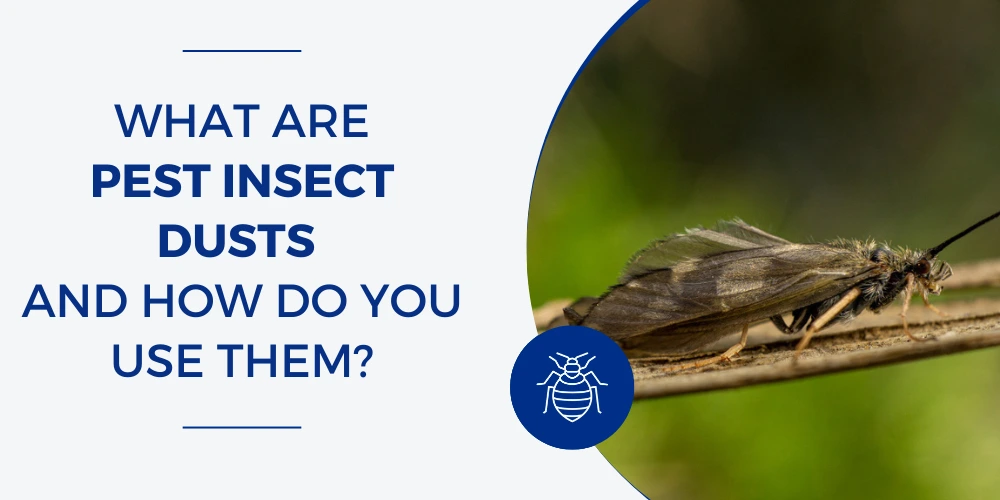If you're looking for effective DIY pest control solutions in Arizona, insect dusts should be an essential part of your arsenal. These dry pest control products can be applied in cracks, crevices, and voids where insects hide and travel, providing long-lasting protection against a variety of common household pests. In this guide, we'll explore what insect dusts are, when and how to use them, and why they're particularly valuable for pest control in Arizona homes.
What Is Insect Dust?
- The term "insect dust" describes a powdered, dry mixture that is used to get rid of or deter insects. These items function differently to fight domestic pests in various forms.
- Composed of fossilized algae, food grade diatomaceous earth (DE) is a natural material that physically harms insects' exoskeletons using microscopic sharp edges.
- By causing tiny holes in insects' bodies, silica gel causes dehydration and the final death of the pest.
- Combining both physical abrasion and poisonous consequences when consumed by insects during grooming, boric acid is a common choice for cockroach treatment.
- With several modes of action, commercial insecticidal dusts include active components especially meant for focused pest control.
- Unlike liquid sprays that could soak into surfaces or evaporate fast, these powders operate by continual action. They either harm the insect's body physically or induce desiccation, which practically dehydrates the pest until it dies.
- Common problems for Arizona residents looking for DIY pest control solutions, including crawling insects like ants, cockroaches, bedbugs, silverfish, and even scorpions, are very well addressed by this technique. The arid Arizona climate increases the efficacy of these items as they stay active longer in low-humidity settings.
When to Use Insect Dust vs Spray or Bait
Knowing when to deploy dust versus other pest control methods is key to successful DIY home pest control in Phoenix, AZ, and can make the difference between effective pest management and wasted effort.
- Insect dusts are ideal for treating inside wall voids where pests travel, but are difficult to reach with liquid sprays. They work exceptionally well in cracks and crevices where liquid treatments might damage materials or leave unsightly residues.
- These products can be safely applied behind electrical outlets and switch plates when proper precautions are taken. Dusts are the preferred choice for areas where you need long-lasting residual protection, as many formulations can remain effective for months.
- They perform best in dry spaces where moisture is not an issue, making them particularly suited for Arizona homes. Many professional exterminators prefer dusts for places where minimal disturbance is preferred after application.
- While DIY pest control spray options work well for immediate knockdown and surface treatments, they often lack the persistence of quality dust formulations. For example, bed bug powder can be applied around bed frames and along baseboards for continuous protection, while wasp killer powder is particularly effective when carefully puffed into wall voids where wasps might be establishing nests.
The key advantage of dust formulations is their ability to remain active long after application, creating an invisible barrier that continues working for weeks or months.
How to Apply Insect Dust Properly
When using DIY pest control products in your house, correct application is essential for both safety and efficacy. Correct methods guarantee you get the most advantage while reducing any possible hazards to your pets or family.
- Wear protective gloves and a dust mask during application to avoid inhalation or skin contact, thereby always giving safety top priority. Different formulations could have particular application instructions or warnings; thus, read product labels carefully before usage.
- Use the dust in a thin, almost undetectable layer; too much use might lower efficacy by driving insects away from heavily treated regions. During application and until dust has settled fully, keep children and pets away from the areas.
- The correct instruments make the application much more exact and efficient. A bulb duster or hand duster guarantees appropriate product distribution and lets you carefully apply it to small areas. Brushing dust into narrow gaps where dusters cannot reach efficiently can be aided by a little paintbrush.
- A plastic squeeze bottle with a tiny hole might act as a makeshift applicator for restricted use in circumstances lacking specialized equipment.
- The most efficient use results from a methodical approach. Before applying, start by thoroughly cleaning the target area to eliminate any material that could interfere with the dust's correct interaction with surfaces.
- Overloading might cause too much application, so load your applicator with a little dust. Remember that less is more with insect dust; apply a thin, fine layer across the target area.
- Treating damp areas should be avoided, as most dust formulations' efficacy is greatly compromised. Heavy applications could drive insects away before they touch the treatment, so be careful not to overapply.
Where to Apply Insect Dust in Your Home
Strategic placement maximizes effectiveness when tackling pest control challenges throughout your home. Understanding the most effective locations can significantly improve your results.
- Dust in cracks and crevices where baseboards meet floors, along window frames, and around door thresholds where insects often travel.
- Access wall voids via electrical outlets, plumbing penetrations, and tiny access holes where insects may enter your living areas to treat them.
- Many insects find perfect hiding places in the areas beneath and behind appliances, including refrigerators, stoves, dishwashers, and washing machines, which should be addressed carefully.
- Dust under sinks, around plumbing pipes, and in cabinet corners where moisture and food supplies usually draw cockroaches and ants.
- Attics, basements, and crawl spaces merit particular focus; use along joists and in corners where insects usually move. Treatments around garage walls and basement foundations help keep outside pests from coming in.
- These focused uses guarantee that insects come across the dust during their regular migration patterns, so increasing the effectiveness of your DIY measures for controlling pests at home and offering ongoing protection for your Arizona house.
How Long Does Insect Dust Last?
One of the main advantages of dust treatments is their impressive longevity compared to other pest control methods. Most insect dusts remain effective for weeks or months if kept dry and undisturbed in your home.
Diatomaceous earth and silica-based products can last up to 6 months under ideal conditions, providing continuous protection against pest infestations. Boric acid treatments are particularly persistent and may remain active for years if left undisturbed, making them excellent choices for long-term preventative control.
In Arizona's characteristically dry climate, dust treatments often last significantly longer than in more humid regions where moisture can degrade the product. However, you should plan to reapply after major cleaning in treated areas that might have disturbed the dust layer.
Seasonal reapplication as part of your preventative routine for pest control in Arizona ensures continuous protection year-round. If you notice renewed pest activity in previously treated areas, this indicates that reapplication may be necessary.
Remember that humidity and moisture significantly reduce the effectiveness of most dust formulations, so you should regularly monitor areas that might get wet from plumbing leaks or condensation. Reapply the product as needed to maintain consistent protection throughout your home.
Tips to Maximize Effectiveness
- Use this expert advice to improve your DIY pest control outcomes and make your treatments more successful.
- To track insect activity and decide whether more treatments are required, put glue traps close to dusted areas.
- For the dust to operate efficiently, avoid vacuuming treated areas for at least two weeks following application.
- To get rid of food supplies and harborage sites that could draw pests, combine dust treatments with comprehensive cleaning and decluttering.
- Seal entry points after treatment to prevent new infestations from establishing in your home.
- Always store unused product in its original container with clear labeling to prevent accidental misuse or exposure. Consider using multiple pest control methods for severe infestations, as integrated pest management approaches typically yield the best results.
- For comprehensive protection, many Arizona homeowners supplement dusting with perimeter sprays and targeted baits, creating a complete DIY home pest control. The system addresses different aspects of pest behavior and biology.
Is It Safe Around Pets and Children?
- Carefully assess the safety issues, which differ based on the product kind, before using a product in a house with vulnerable family members.
- Natural choices like food-grade diatomaceous earth are usually thought acceptable for usage around the house, but can irritate the breathing if breathed in significant amounts. Some formulations are meant for outdoor or agricultural usage and may have extra components, so always use the correct grade of product for interior pest control.
- To guarantee family safety, synthetic dusts need extra careful handling. To reduce any possible hazards, always follow label directions exactly.
- Use these items exclusively in places off-limits to children and dogs, including inside wall voids or behind appliances. Until the dust has all settled, think about moving pets temporarily during and just after application.
- Apply dusts in cracks, voids, and behind baseboards instead of in open locations where exposure is more probable for maximum safety in your home. To avoid unintentional contact or inhalation, wipe up any apparent extra powder in living areas.
- Until dust has completely settled and is no longer airborne, keep pets and children away from recently treated areas. If you are worried about using these products properly, particularly in households with people with respiratory diseases or compromised immune systems, think about getting professional assistance for serious infestations.
Conclusion
You may effectively include dust treatments in your comprehensive pest control strategy if you know the correct application methods and safety measures.
Visiting Bug & Weed Mart will give you expert guidance on choosing the appropriate items for your particular pest issues if you want to handle pest issues yourself, but don't know where to begin. Their experienced team can assist you in selecting the most efficient dust formulas for Arizona's particular pest concerns and environmental variables.
Using the correct equipment and information, you may safely and successfully manage pest issues in your Arizona house, safeguarding your family and property from unwelcome intruders.

